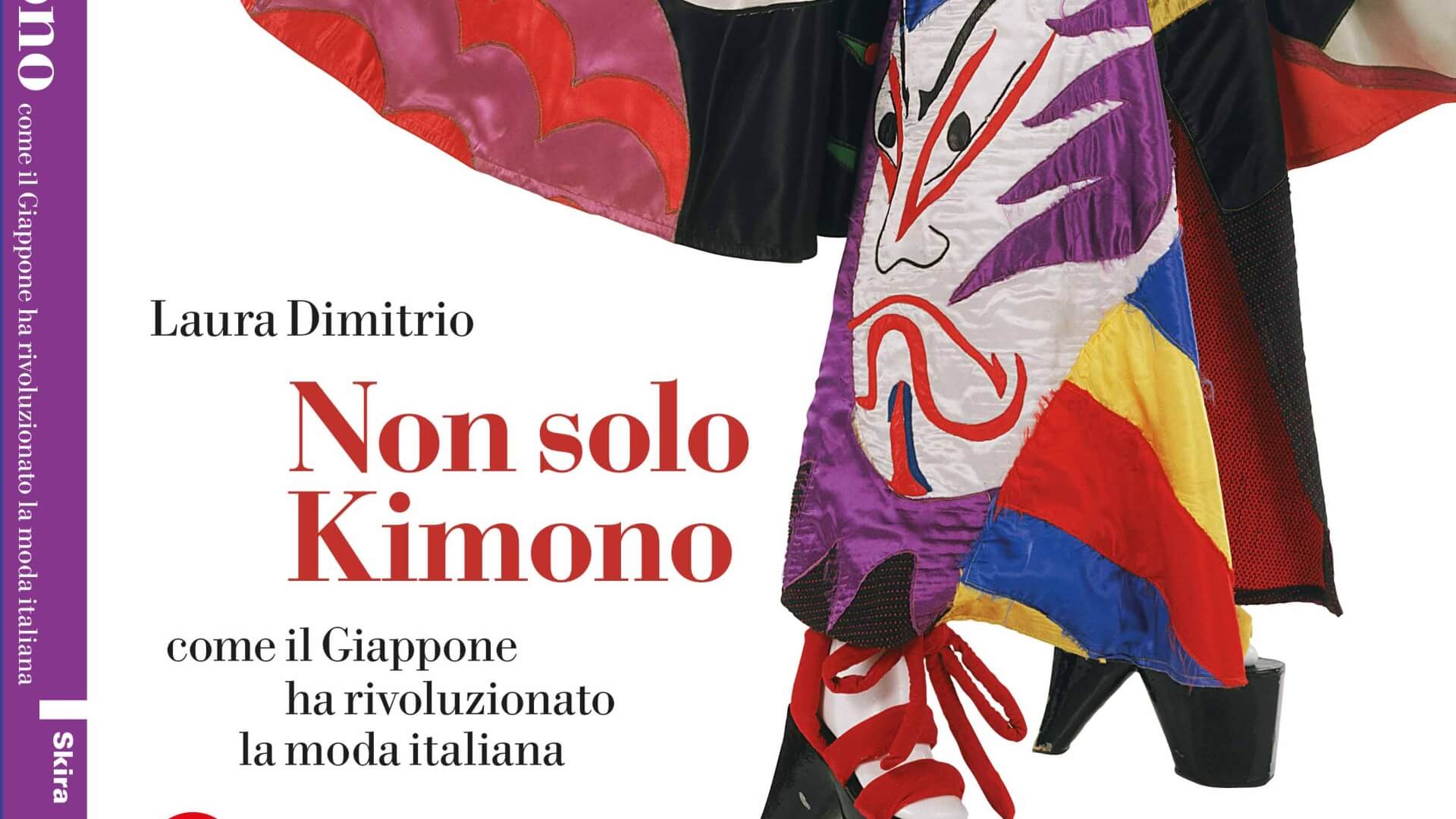
A Talk With Laura Dimitrio Author of: "Non Solo Kimono. Come il Giappone Ha Rivoluzionato la Moda Italiana"
Laura Dimitrio author of "Non solo kimono. Come il Giappone ha rivoluzionato la moda italiana" has answered some questions about her book for Seishou's blog. We'll find out everything about her work and background ideas.
Laura Dimitrio is a researcher and an expert in fashion history. She has done special studies on Japonisme and Italian fashion of the 20th century.
She graduated at the School of Art History and for her final thesis she choose the topic: history of fashion.
Her publications include essays on Italian Japonisme, the costumes for the premiere of Madama Butterfly, and the working conditions of seamstresses in the 20th century.
- First of all, how does one become a fashion writer?
- Tell us how your passion for Japan and its culture came about?
- Why exactly was the kimono the representative symbol of Japanese culture and fashion in the world?
- Why do you think Japanese aesthetics in particular has had this great influence on the evolution of fashion worldwide?
- In your latest book “Non solo kimono. Come il Giappone ha rivoluzionato la moda italiana” (“Not only Kimono. How Japan has revolutionised Italian fashion) you mention the influence of Italian fashion on Japanese culture. Can you tell us about this influence?
- Pop-Japanism: what do you think about the 'kawaii' style and the current cultural dialogue and fashion revolution of Gen-Z in Italy? How do you think it will evolve in the future, based on your studies?
- What do you think about the fact that avant-garde Japanese designers such as Kenzo, Miyake, Yamamoto, Kawakubo have tried to abolish ethnic distinctions in fashion?
- Do you think too much outside influence can damage the authenticity of Japan's millennial culture?
- The aesthetics of imperfection originating in the Japanese concept of "wabi sabi," of which Kawakubo's style may be an example, has changed the concept of beauty today. How?
- The concept of "wabi sabi" was initially denigrated and later imitated globally, what was the mindset change that enabled it?
- What do you think were and how would you define the positive influences of Japonisme (in its evolution) on classic Italian glamour?
- The influence of Japanese culture is also evident in the area of shoes, for example in the images on page 152, in Prada's 2013 collection. Do you think this Japanese influence comes mainly from typical Geta and "tabi" socks?
- Considering haute couture, do you think the choice to draw inspiration from traditional Japanese sandals for footwear was a choice of stylistic consistency inspired by clothing reminiscent of the kimono?
First of all, how does one become a fashion writer?
Honestly, I feel more like a fashion historian rather than a fashion writer. In college, I was an art history major.
During my later years at the Graduate School of Art History, I took a course on the history of costume and fashion. It was there that my passion for fashion history was born.
Or rather, I already had a passion for fashion, but thanks to that course, I discovered that it was possible to study the subject with an academic approach.
After several years of study, I began to find topics that interested me because they were still unexplored. I started writing articles and book chapters about these topics.
Tell us how your passion for Japan and its culture came about?
For the Graduate School of Art History thesis, I chose a topic related to the history of fashion. I examined sketches by the Italian painter Giuseppe Palanti for the costumes of the premiere of Madama Butterfly.
This drama was set to music by Giacomo Puccini and premiered at La Scala in Milan in 1904.
Since Madama Butterfly is set in Japan, most of the performers wore Japanese clothing. To understand whether the costumes designed by Palanti were realistic, I began to study the features of authentic kimonos.
From then on, I became interested in the evolution of Japanese clothing and the influence it had in Europe and especially in Italy. At the same time, I studied the success of Japanese culture in the West and in Italy, especially from the late nineteenth century, during the phenomenon of "Japonisme".
What were the volumes (or shows) that most sparked your interest in writing about fashion?
The books that have sparked my interest in fashion history are mainly catalogs of exhibitions organized by major museums such as the Metropolitan Museum in New York or the Victoria and Albert Museum in London.
In particular, the catalog of the exhibition Japonisme & Mode, held first in Japan and then at the Palais Galliera in Paris in 1996, was a fundamental book for my studies.
This volume, which analyzed Japanese influences on French fashion in particular, awakened in me a desire to understand how Japanese styles had penetrated Italian fashion.
Also, the volume Fashion. A History from the 18th to the 20th Centuries, published by the Kyoto Costume Institute. A History from the 18th to the 20th Centuries, published by the Kyoto Costume Institute. This book contains many informative illustrations of garments kept in the prestigious Japanese museum, showing the evolution of European and Japanese fashion.
Why exactly was the kimono the representative symbol of Japanese culture and fashion in the world?
The kimono was and is considered the symbol of Japanese fashion all over the world, mainly because it is the garment that has characterized Japanese clothing for centuries and is different from that of other countries.
The kimono was appreciated in Europe and Italy at the end of the nineteenth century mainly because it was considered a comfortable garment, very different from the dresses with rigid corsets that the fashion of the late nineteenth century imposed on the ladies.
Why do you think Japanese aesthetics in particular has had this great influence on the evolution of fashion worldwide?
Japanese aesthetics has provided "Western" culture with a new perspective and understanding of beauty, especially since the late 19th century.
Just think of the importance in Japanese culture of the terms wabi sabi (which could be translated as "imperfect and incomplete beauty") and ma (indicating an interval, an in-between space), which are completely unknown to "Western" aesthetics.
These concepts are the cultural foundation on which the Japanese avant-garde designers, especially Yohji Yamamoto and Rei Kawakubo with her brand Comme des Garçons, have built their style and their idea of beauty.
In your latest book “Non solo kimono. Come il Giappone ha rivoluzionato la moda italiana” (“Not only Kimono. How Japan has revolutionised Italian fashion) you mention the influence of Italian fashion on Japanese culture. Can you tell us about this influence?
In my book: "Non solo Kimono. Come il Giappone ha rivoluzionato la moda italiana", editor Skira, I have focused on the influence of Japan on Italian fashion. However, it is true that Italian fashion has also been appreciated in Japan, especially since the 1970s.
I am thinking, for example, of Mila Schön, the founder of the Milan fashion house of the same name: the strict lines and refined elegance of her creations were so successful in Japan that her house was later taken over by the Japanese financial group Itochu, to which it still belongs.
But the collections of Giorgio Armani, Prada and Gucci also continue to be successful. Recently, Giorgio Armani said in an interview that "the Japanese are more Armani than Armani."
Pop-Japanism: what do you think about the 'kawaii' style and the current cultural dialogue and fashion revolution of Gen-Z in Italy? How do you think it will evolve in the future, based on your studies?
With the new millennium, young Italians, like young people around the world, have become particularly receptive to Japanese subcultures.
These subcultures included, for example, Lolitas, or girls who dressed like Victorian-era dolls, and cosplayers, or young people who dressed like manga or anime characters. In addition to Lolitas and cosplayers, the Kawaii style (which can be translated as "carino" in Italian and "cute" in English) has also spread in Italy.
Kawaii clothing is childlike and includes lots of little bows and hearts. It is interesting that with the beginning of the new millennium, several Italian fashion houses have included this new style of Japanese matrix in their collections, which are also aimed at adult female customers, not just teenagers.
Just think of the Love Therapy brand, founded in 2003 by Elio Fiorucci, or Moschino's Spring/Summer 2022 collection.
In my opinion, the kawaii style will also be in the collections of some Italian fashion houses in the coming years, because in these difficult times, when pandemics and wars make us sad, this fresh and colorful style has a calming effect and conveys an optimistic message of lightness and cheerfulness.
What do you think about the fact that avant-garde Japanese designers such as Kenzo, Miyake, Yamamoto, Kawakubo have tried to abolish ethnic distinctions in fashion?
These designers never agreed to be called Japanese avant-garde fashion, because although they were from Japan, they also showed their collections in Paris.
Moreover, in their collections they contaminated some features of the kimono, such as certain patterns or the two-dimensional conception of the garment, with features they had adopted from other cultures.
In this sense, Kenzo was a master of garment contamination, as he also drew inspiration from cultures far removed from his own, such as Latin American or Eastern European.
In the 1970s and 1980s, these Japanese designers in some way anticipated the globalization of fashion, which today is undisputed.
Do you think too much outside influence can damage the authenticity of Japan's millennial culture?
I don't think so. Since the 16th century, when some Portuguese merchants first landed on Japanese shores, Japan has shown great interest in the culture of the "foreigners," who were assimilated, but without affecting Japanese cultural identity.
Thus, during the Meiji period (1868-1912), a process of "Westernization" was initiated in Japan, affecting not only culture but also the economy.
With the slogan "Japanese spirit, Western technology," an attempt was made to reconcile the values of Japanese tradition with the technical modernization of the country - in my opinion with success.
Even today, Japan is a super-technological country and perhaps the most Westernized country in Asia. Nevertheless, traditions are still deeply rooted in the mentality of the Japanese.
The aesthetics of imperfection originating in the Japanese concept of "wabi sabi," of which Kawakubo's style may be an example, has changed the concept of beauty today. How?
In European fashion, especially in haute couture, the idea prevailed at least until the 1970s that a dress was only beautiful and valuable if it was not only made of precious fabrics but also perfectly sewn to accentuate the female silhouette as much as possible.
The concept of wabi sabi, which can be found above all in the collections of Yohji Yamamoto and Rei Kawakubo-Comme des Garçons, has completely upset these "Western" certainties.
According to these avant-garde designers, a dress was beautiful if it was loose, shapeless, asymmetrical, unfinished, frayed, with holes and tears. "I think perfection is ugly," Yohji Yamamoto explained. These designers created a real revolution in fashion.
The concept of "wabi sabi" was initially denigrated and later imitated globally, what was the mindset change that enabled it?
Yes, that's right, at first Yamamoto and Kawakubo's fashion was called "post-atomic" by the press because the models in their frayed and punctured clothes looked as if they had survived a nuclear explosion.
Over time, their loose-fitting dresses were also appreciated because they freed the female body from all forms of restriction. One Italian fashion designer who appreciates her new aesthetic ideas is Miuccia Prada.
She recently said: "Ugly is attractive, ugly is exciting. Maybe because it's newer." Still, Prada has not readily adopted the aesthetic of avant-garde Japanese designers, as she has brought a touch of chic to her creations, so much so that the term "ugly chic" has been coined for her style.
What do you think were and how would you define the positive influences of Japonisme (in its evolution) on classic Italian glamour?
Japonisme is a trend that has been running through Italian fashion since the late 19th century and is still alive today. There were times when Japonisme was more prominent, such as in the early 1970s and 1980s.
With each wave of Japonisme, various features of kimono or avant-garde Japanese fashion were brought into fashion.
It is interesting to note that whenever Italian fashion adopted some features of Japanese clothing, it created a new and distinct form of fashion.
In other words, every Italian fashion designer who was inspired by Japan reinterpreted it in the light of his own style.
Think, for example, of Ken Scott's Kimonomania collection from 1971, which features faces of Kabuki actors, or Fausto Puglisi's Pop Yukatas from 2017.
The influence of Japanese culture is also evident in the area of shoes, for example in the images on page 152, in Prada's 2013 collection. Do you think this Japanese influence comes mainly from typical Geta and "tabi" socks?
Right, of course. In its spring-summer 2013 collection, Prada pays homage to Japan by reinterpreting the kimono in a pop way.
Footwear also played an important role in these looks, which alluded to traditional Japanese dress.
They were free reinterpretations of tabi, which are socks with the big toe separated from the other toes, and geta, which are wooden sandals usually worn with the yukata. (You can read more about Geta on Seishou's dedicated article).
Some of the tabi made by Prada were even made with silver or gold metallic threads.
Considering haute couture, do you think the choice to draw inspiration from traditional Japanese sandals for footwear was a choice of stylistic consistency inspired by clothing reminiscent of the kimono?
I think so. Especially recently, designers have extended their research to accessories of traditional Japanese clothing.
Just think of the tabi boots that Belgian fashion designer Martin Margiela proposed in his first collection in 1989 and that are still being produced today.
These are boots or other shoes such as ballerinas or mary-jane shoes inspired by the tabi, because in these shoes the big toe is also separated from the other toes, just like the tabi.
Many thanks to Laura Dimitrio for this interesting interview and for taking the time to dedicate to Seishou's blog. We hope you enjoyed learning about the kimono tradition and the influence of Japanese fashion on Italian fashion.







